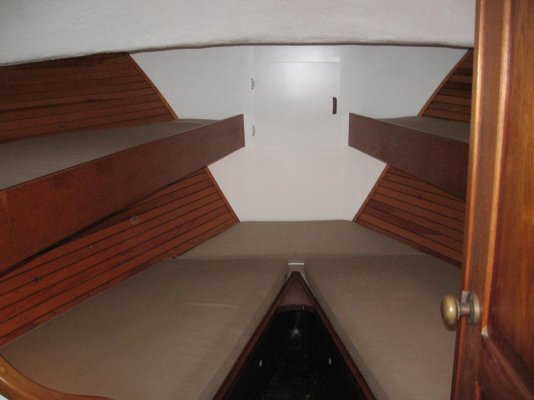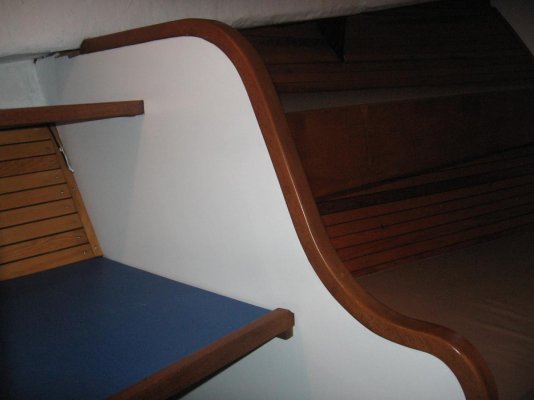Dougcole
Guru
Hi All,
The recent discussion on furring strips has gotten me thinking of a possible project, and I'd like to solicit input from the board.
The hull sides in the fwd cabin of our Mainship 400 are covered with a foam backed vinyl that is glued to the hull. The vinyl was installed and then the cabin furniture was installed over the top of it. On our boat the top layer of the vinyl is peeling off, that is to say it is still attached to the hull, but the outer layer (sort of like paint) is flaking off.
I had a vinyl guy give me a quote on replacement, and he said in the $4,000 range as it would be a difficult and messy job to remove it. I've seen a few solutions to this, including one of our TF members who covered it with carpet, which looked nice and was fairly inexpensive, about $1,100.
But here's the rub. I have access to a big warehouse STUFFED with marine hardwoods. The owner has offered me anything I want from it for free. I'm quite certain that I can find enough strips of either teak or cherry to cover the insides of the hull. I could also use a solid panel with a veneer laminated to it.
So here's the questions that come to mind.
1. How to attach the furring strips to the hull sides? The hull is cored in that area, do you think I can screw into it?
2. Can I get away without removing the foam backed vinyl? I'm wondering If I can screw the furring strips right through it into the hull sides. If I went with slats, I think it would look nice in between the slats.
3. See any glaring obstacles I may face? I'm a pretty good carpenter and I have access to really good table saws, router tables, drum sanders et.
The recent discussion on furring strips has gotten me thinking of a possible project, and I'd like to solicit input from the board.
The hull sides in the fwd cabin of our Mainship 400 are covered with a foam backed vinyl that is glued to the hull. The vinyl was installed and then the cabin furniture was installed over the top of it. On our boat the top layer of the vinyl is peeling off, that is to say it is still attached to the hull, but the outer layer (sort of like paint) is flaking off.
I had a vinyl guy give me a quote on replacement, and he said in the $4,000 range as it would be a difficult and messy job to remove it. I've seen a few solutions to this, including one of our TF members who covered it with carpet, which looked nice and was fairly inexpensive, about $1,100.
But here's the rub. I have access to a big warehouse STUFFED with marine hardwoods. The owner has offered me anything I want from it for free. I'm quite certain that I can find enough strips of either teak or cherry to cover the insides of the hull. I could also use a solid panel with a veneer laminated to it.
So here's the questions that come to mind.
1. How to attach the furring strips to the hull sides? The hull is cored in that area, do you think I can screw into it?
2. Can I get away without removing the foam backed vinyl? I'm wondering If I can screw the furring strips right through it into the hull sides. If I went with slats, I think it would look nice in between the slats.
3. See any glaring obstacles I may face? I'm a pretty good carpenter and I have access to really good table saws, router tables, drum sanders et.




